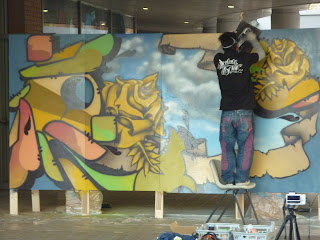This past week was Kansai Gaidai University’s annual cultural festival “Gaidai-sai” in which the students participated in various fundraising campaigns for their respective clubs and had the opportunity to showcase their talents through a wide variety of activities. While the Japanese students got the majority of the week off, the international students only got Wednesday as a holiday. Nevertheless I was appreciative and decided to venture into Shinsaibashi with some friends on our day off.
While there, I enjoyed simply walking around and looking at the variety of visual stimuli that can at times be overwhelming. In such a dense area, it is easy to overlook many interesting things, but as I was walking down one of countless small side roads, I glanced across the street and saw a rather large piece of art on the wall next to a small café—it was an enlarged stylized image of a man’s face that stared back at me.
Upon further investigation I noticed that on the left cheek was a series of sign language characters. This greatly intrigued me and I decided to take a few photos. I was interested to know what the characters were, but was disappointed when I could not find a sign language alphabet that had all of the present characters.
The image itself is in appearance simple and looks cool, but because the only description present is in a form of sign language I am not able to fully understand the reason or meaning behind the image itself. For all I know it could be simply an advertisement for something or have a more significant meaning. This made me feel in a small way slightly illiterate; having no prior experience in sign language, I felt that in only being able view the image I was missing something. The image itself had served its purpose in drawing my attention, but without being able to comprehend the message, it left me feeling slightly puzzled. After seeing this image it made me realize that in this case, the description (sign language) is just as important as the image itself—in order to take any meaning from it, one must both view the image as well as the description.
On Saturday I went to the Gaidai-sai festivities and had a fun time just wondering through eating the student-made food and watching the various performances, but the most interesting exhibition was the graffiti murals across from the shokudo.
I enjoyed watching the student artists progressively work piece by piece to finish their murals. While at the festival, I made it a point to periodically return to the area to check on the progress—each time I did so, the art took on a more defined shape. It was a good idea not only to showcase the artwork, but also to have the artists actively work on their pieces for the benefit of the viewing audience. By doing so the art becomes more tangible in that the viewer is able to witness the process and the intricate steps it takes to develop the finished product. Because I have an interest in that particular genre of art, I really appreciated being able to watch the artist’s methods and techniques as they worked.



The finger spelling, if ASL, says "magnets."
ReplyDeleteGraffiti murals is an interesting topic for a post - would like to see and read more on this.